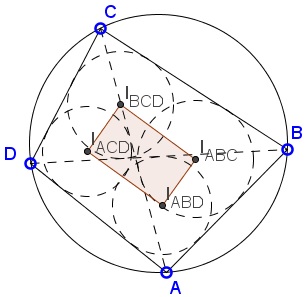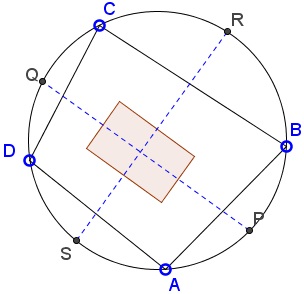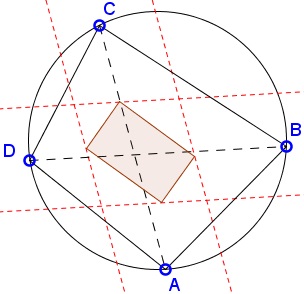Incenters in Cyclic Quadrilateral:
What is this about?
A Mathematical Droodle
|Activities| |Contact| |Front page| |Contents| |Geometry|
Copyright © 1996-2018 Alexander BogomolnyIncenters in Cyclic Quadrilateral
Every (convex) quadrilateral ABCD defines four triangles: BCD, ACD, ABD, and ABC. The applet is an attempt to convey an assertion often referred to as the Japanese theorem:
The incenters of the four triangles form a rectangle.

Proof
From ΔBCD, ∠BIBCDC = 90° + ∠BDC/2.
Similarly, from ΔABC, ∠BIABCC = 90° + ∠BAC/2.
However, since we assumed that the quadrilateral ABCD is cyclic, ∠BDC = ∠BAC. Therefore, also
| (1) | ∠BCIBCD + ∠BIABCIBCD = 180°. |
Similarly the quadrilateral AIABDIABCB is cyclic, so that
| (2) | ∠BAIABD + ∠BIABCIABD = 180°. |
(1) and (2) imply that
∠BIABCIBCD + ∠BIABCIABD = 360° - ∠BCD/2 - ∠BAD/2 = 270°.
Which gives
| (3) | ∠IABDIABCIBCD = 90°. |
Other angles are treated similarly. Q.E.D.
In addition, let P, Q, R, and S be the midpoints of the arcs AB, CD, BC, and AD, respectively.

This is #3.5 from Fukagawa and Pedoe's collection. It was written on a 1880 tablet in the Yamagata prefecture. Maruyama Ryoukan posted a tablet in 1800 at the Sannosha shrine in Tsuruoka city of Yamagata prefecture with the observation that [Fukagawa and Rothman, p. 192]
rABC + rACD = rABD + rBCD.
(In itself, this is a particular case of what is known as the Old Japanese Theorem.)
This implies that the lines through the incenters parallel to the diagonals form a rhombus.

You may observe that the arc bisectors of the arcs subtended by the sides of the quadrilateral serve as the diagonals of the rhombus.
References
- H. Fukagawa, D. Pedoe, Japanese Temple Geometry Problems, The Charles Babbage Research Center, Winnipeg, 1989
Write to:
Charles Babbage Research Center
P.O. Box 272, St. Norbert Postal Station
Winnipeg, MB
Canada R3V 1L6 - H. Fukagawa, A. Rothman, Sacred Geometry: Japanese Temple Geometry, Princeton University Press, 2008
- D. Wells, You Are A Mathematician, John Wiley & Sons, 1995
Sangaku
- Sangaku: Reflections on the Phenomenon
- Critique of My View and a Response
- 1 + 27 = 12 + 16 Sangaku
- 3-4-5 Triangle by a Kid
- 7 = 2 + 5 Sangaku
- A 49th Degree Challenge
- A Geometric Mean Sangaku
- A Hard but Important Sangaku
- A Restored Sangaku Problem
- A Sangaku: Two Unrelated Circles
- A Sangaku by a Teen
- A Sangaku Follow-Up on an Archimedes' Lemma
- A Sangaku with an Egyptian Attachment
- A Sangaku with Many Circles and Some
- A Sushi Morsel
- An Old Japanese Theorem
- Archimedes Twins in the Edo Period
- Arithmetic Mean Sangaku
- Bottema Shatters Japan's Seclusion
- Chain of Circles on a Chord
- Circles and Semicircles in Rectangle
- Circles in a Circular Segment
- Circles Lined on the Legs of a Right Triangle
- Equal Incircles Theorem
- Equilateral Triangle, Straight Line and Tangent Circles
- Equilateral Triangles and Incircles in a Square
- Five Incircles in a Square
- Four Hinged Squares
- Four Incircles in Equilateral Triangle
- Gion Shrine Problem
- Harmonic Mean Sangaku
- Heron's Problem
- In the Wasan Spirit
- Incenters in Cyclic Quadrilateral
- Japanese Art and Mathematics
- Malfatti's Problem
- Maximal Properties of the Pythagorean Relation
- Neuberg Sangaku
- Out of Pentagon Sangaku
- Peacock Tail Sangaku
- Pentagon Proportions Sangaku
- Proportions in Square
- Pythagoras and Vecten Break Japan's Isolation
- Radius of a Circle by Paper Folding
- Review of Sacred Mathematics
- Sangaku à la V. Thebault
- Sangaku and The Egyptian Triangle
- Sangaku in a Square
- Sangaku Iterations, Is it Wasan?
- Sangaku with 8 Circles
- Sangaku with Angle between a Tangent and a Chord
- Sangaku with Quadratic Optimization
- Sangaku with Three Mixtilinear Circles
- Sangaku with Versines
- Sangakus with a Mixtilinear Circle
- Sequences of Touching Circles
- Square and Circle in a Gothic Cupola
- Steiner's Sangaku
- Tangent Circles and an Isosceles Triangle
- The Squinting Eyes Theorem
- Three Incircles In a Right Triangle
- Three Squares and Two Ellipses
- Three Tangent Circles Sangaku
- Triangles, Squares and Areas from Temple Geometry
- Two Arbelos, Two Chains
- Two Circles in an Angle
- Two Sangaku with Equal Incircles
- Another Sangaku in Square
- Sangaku via Peru
- FJG Capitan's Sangaku
|Activities| |Contact| |Front page| |Contents| |Geometry|
Copyright © 1996-2018 Alexander Bogomolny73454346
